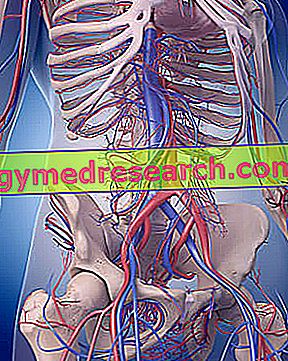Generality
The ascending aorta is the first important part of the aorta, which is the main artery of the human body.

Connected to the left ventricle of the heart and oriented towards the head (therefore upwards), the ascending aorta is born at the level of the third sterno-costal articulation and ends, continuing with the aortic arch, at the same height as the handlebar articulation- sternal and IV thoracic vertebrae.
Generally 5-6 centimeters long and usually not more than 3 centimeters wide, the ascending aorta is the site of origin of the right coronary artery and of the left coronary artery, that is the arterial vessels destined to nourish and keep alive the heart.
From the pathological point of view, the ascending aorta can be the victim of dilatation, aneurysms or calcifications.
Short review of the aorta
The aorta is the largest and most important artery in the human body.
Originating in the heart (to be precise from the left ventricle of the heart ), this fundamental arterial vessel is provided with numerous ramifications, through which it supplies every district of the human body with oxygenated blood, from the head to the lower limbs, passing through the limbs upper and trunk.
Analyzing it from the beginning, the aorta is didactically divided into two large consecutive sections: the thoracic aorta, occupying the anatomical portion of the thorax, and the abdominal aorta, located in the anatomical portion of the abdomen.
What is the Ascending Aorta?
The ascending aorta is the first significant tract in the anatomy of the thoracic aorta.
This means that, as the thoracic aorta is the first section of the aorta, an equally valid definition for the previous ascending aorta can be: the ascending aorta is the first important aorta tract.
Anatomy
Connected to the left ventricle of the heart and located in the pericardium, the ascending aorta is born at the level of the lower edge of the third sterno-costal articulation, posterior to the left half of the sternum .
The third (III) sterno-costal articulation is the joint that joins the sternum - that is the long flat bone located at the center of the thorax and constituting a fundamental part of the thoracic cage - to the costal cartilage of the third rib (or rib ).

From the beginning, the ascending aorta has an upward orientation (this explains the why of the term "ascending") and tending towards left and forward.
Its course ends at the level of the dumbbell-sternal articulation, which is placed at the same height as the second sterno-costal articulation and the thoracic vertebrae ; where the ascending aorta ends, the so-called aortic arch immediately begins.

5-6 centimeters long and with a characteristic curved shape, the aortic arch is the second important part of the thoracic aorta (and, given its direct connection with the ascending aorta, it is also the second most relevant part of the aorta ).
The aortic arch is responsible for the change in orientation of the aorta - the orientation that projects the latter downwards - and the birth of the first three large-caliber branches of the largest artery of the human body, namely the brachiocephalic trunk, the carotid artery common left and the left subclavian .
From the point of view of size, the ascending aorta generally measures 5-6 centimeters in length and 3 centimeters in diameter (NB: these measures vary according to the age and size of the human body).
Did you know that ...
In a very tall individual of considerable build, the ascending aorta may have a diameter greater than 4 centimeters.
Origin of the ascending aorta: the details
The ascending aorta originates in the upper part of the base of the left ventricle of the heart; here, it is in connection with the aortic valve (ie the valve that regulates the passage of oxygenated blood from the heart to the aorta), through the so-called aortic root .
The aortic root can be defined as the short segment of ascending aorta, which goes from the so-called aortic anulus (fibrous ring that surrounds the aortic valve orifice) to the so - called sino-tubular junction (border region that marks the end of each relationship between the 'ascending aorta and aortic valve).

The most characteristic element of the aortic root is its very first portion, called the aortic bulb ; the latter is a swelling, the result of the presence of the three so-called aortic sinuses (or sinuses of Valsalva ), in each of which is contained one of the three flaps of the aortic valve.
In summary, therefore, the ascending aorta begins its course with a particular structure (the aortic root), whose characteristic initial swelling (the aortic bulb) represents, in fact, the connecting element with the heart.
Did you know that ...
For most anatomists, the aortic root belongs to the ascending aorta; for a small faction of experts, instead, it is an element in itself.
As readers can see from the description above, this article ranks with the most common view, therefore it considers the aortic root the element of the ascending aorta that joins the latter to the aortic valve.
Central and terminal portions of the ascending aorta: the details
If for the central portion of the ascending aorta there is no anatomical detail to report, for the terminal portion of the ascending aorta (that is, just before the aortic arch) it is necessary to communicate to the readers the presence of a slight swelling exclusively on the side right, which is named big aortic sinus .
Branches of the aortic arch
To understand…
The branches of an artery are its branches .
Just beyond the aortic sinuses, but still within the aortic root, the ascending aorta gives rise to two small caliber branches, which are the famous left coronary artery and right coronary artery . Oriented respectively to the left and to the right, the left coronary artery and the right coronary artery are the arterial vessels designed to diffuse oxygenated blood into the myocardium (ie the heart muscle), thus keeping the heart alive.

Relationships of the ascending aorta
The ascending aorta borders:
- Anteriorly and only for the initial portion, with the main pulmonary artery (or pulmonary trunk) and the right auricle.
- Anteriorly and in the upper region, with the layer of pericardium interposed between it and the sternum, the right pleura and the thymus.
- Later, with the right pulmonary artery and the right main bronchus.
- To his right, with the right atrium of the heart.
- On his left, with the left atrium and the upper part of the main pulmonary artery.
Function
The ascending aorta covers two important functions: a more general one, which consists in ensuring the diffusion of oxygenated blood leaving the heart towards the successive segments of the aorta (aortic arch, descending aorta and thoracic aorta), and a more specific one, which instead consists in channeling the oxygenated blood into the coronary arteries, ie the arteries responsible for keeping the heart alive.
diseases
The ascending aorta can be the victim of dilatation, aneurysms or calcifications .
Dilation of the ascending aorta
With dilation of the ascending aorta, the doctors intend any localized swelling of the aorta tract in question, such that the vessel diameter measures more than 3.5 centimeters but less than 4.5 centimeters.
As a rule, dilation of the ascending aorta is not associated with any symptoms, but this does not mean that it is not dangerous; where the ascending aorta is dilated, in fact, the vessel walls are more delicate and easy to break, and the blood flow is more turbulent and prone to giving rise to abnormal blood clots or blood clots.
Currently, doctors have not yet recognized a precise cause at the origin of the ascending aorta dilation; however, they agree that factors such as: have a fundamental influence on the phenomenon in question:
- Aging ;
- Atherosclerosis ;
- Hypertension ;
- Cigarette smoke ;
- The vasculitis of the aorta;
- Genetics .
Did you know that ...
The rupture of a vessel as important as the aorta can give rise to internal hemorrhage with a often lethal outcome; the formation of thrombi or abnormal blood clots in the aorta, on the other hand, can represent the trigger for episodes of stroke or obstruction of the coronary arteries.
Aneurysm of the ascending aorta
Aneurysms of the ascending aorta are localized swellings of the aorta tract in question, such that the vascular diameter reaches a height of at least 1.5 centimeters more than normal.
From a certain point of view, aneurysms of the ascending aorta are very serious cases of dilation, in which the vessel caliber has exceeded 4.5 centimeters.

Although they often lack a correlated symptomatology, the aneurysms of the ascending aorta represent an important threat for the survival of the bearer; in fact even worse than the expansions described above, in fact, they are presences that make the vascular wall of the affected aorta tract more fragile and subject to breakage, and that favor the formation of abnormal blood clots or thrombi.
At present, the precise cause of ascending aorta aneurysms is unknown; however, as in the case of dilation of the same aorta tract, doctors agree on their correlation to factors such as aging, atherosclerosis, hypertension, cigarette smoking, vasculitis and genetic predisposition.
Did you know that ...
In medicine, ascending aortic aneurysms are special cases of thoracic aortic aneurysm.
Calcification of the ascending aorta
The doctors talk about calcification of the ascending aorta, when calcium deposits form on the latter which reduce elasticity and make it more rigid.
Mainly related to atherosclerosis and to less common conditions such as Takayasu arteritis, calcification of the ascending aorta involves blood perfusion problems.



